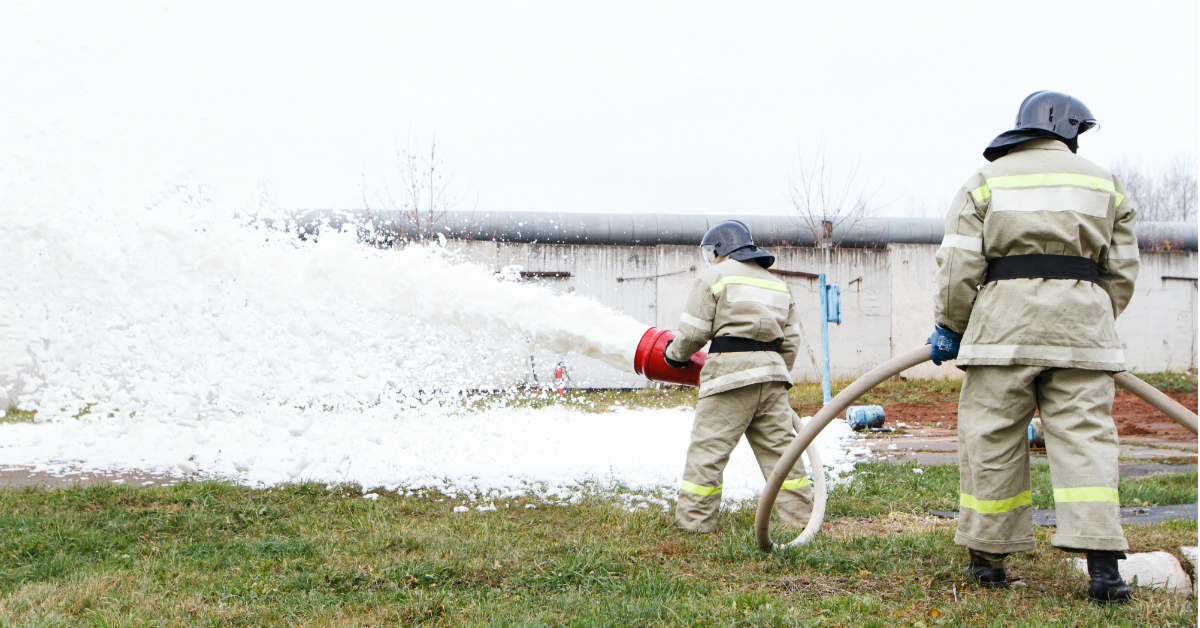UPDATE: Both the U.S. House and Senate have passed versions of the military spending bill including provisions to phase out PFAS-containing firefighting foam, but with different timelines. The bill now heads to a conference committee.
The use of PFAS chemicals in firefighting foam is a major source of drinking water contamination, with PFAS chemicals contaminating the water of at least 1 in 20 Americans. A large amount of this contamination comes from military bases across the country.
Following the recent passage of state laws in Washington and Colorado that ban the sale of firefighting foams containing PFAS chemicals, Congress is now considering the issue as part of the military spending bill—the National Defense Authorization Act (NDAA). Both the House and Senate bills include proposals to phase out the use of toxic PFAS foam by the military.
This is an important opportunity to prevent further drinking water contamination by stopping a major use of toxic PFAS foam. The issue may come to a vote as soon as this month!
Preventing the use of these chemicals to avoid further contamination and disease has never been more important than now. PFAS are used in everyday products from food packaging to firefighting foams, resulting in widespread pollution with PFAS that don’t break down and end up in our bodies. PFAS have been linked to increased risk for certain cancers , liver and kidney toxicity, suppression of the immune system, and elevated cholesterol. Firefighters are especially at risk of high exposure to these chemicals, which is why the firefighters have been some of the leading voices calling for an end to the use of these chemicals.
The Department of Defense estimates that cleanup of military bases across the country due to foam use will cost at least $2 billion, and this price tag doesn’t even begin to cover healthcare costs for contaminated communities. In Washington state, the City of Issaquah spent over $1 million on a water filtration system to address PFAS contamination, and ensuring that residents of Airway Heights have drinkable water for a year will cost $687,000. Both cities’ water contamination can be traced to the use of PFAS-containing firefighting foam for military training.
We don’t have to choose between clean drinking water and fighting fires. Safer alternatives are already in use throughout the country and world. For example, a recent fire at Seattle’s Lake Union was put out using a fluorine-free firefighting foam, chosen by the fire department for its effectiveness and superior environmental profile.
Despite the availability of these safer alternatives, the U.S. military is still using these toxic PFAS foams. PFAS chemicals can persist indefinitely in the environment and cleanup is very difficult and expensive. The only solution is prevention, and the sooner these foams can be phased out, the better! If the use of PFAS in firefighting foam continues, contamination of the environment and our drinking water will continue. Of course, contamination of drinking water leads to contamination of people.
Please join us in calling your Senators and Representatives and telling them that “sooner is better”—the military should stop using these highly toxic chemicals immediately!
The largest opposition to phasing out PFAS-containing firefighting foam are the makers of PFAS chemicals. The chemical industry is lobbying hard in order to make sure as many uses of PFAS in products remain allowed. Recent reports suggest that the chemical industry knew of the dangers from some of first PFAS made, but continued to make them for decades. With this long history of deceit, why would we trust the chemical industry now?
Addressing PFAS use in firefighting foam is just one piece of the puzzle in addressing the PFAS contamination crisis. Federal action to ban the military use of PFAS-containing firefighting foams is especially important to turn off the tap on one of the biggest sources of drinking water contamination across the country.
We’re glad to see an attempt at action at the federal level, but it is important the foams be phased out as soon as possible to prevent further contamination. Join us in calling for an end to the use of PFAS firefighting foam by the military in the shortest possible timeline.
Find the number for your House Representatives
Talking points:
- I am concerned by the use of firefighting foams containing toxic PFAS chemicals by the military. These chemicals have contaminated drinking water across the country and safer alternatives to firefighting foam exist.
- I support the Senate provision (S. 1790) of the National Defense Authorization Act, which would end the use of PFAS foams by 2023. I urge you to support a similar shorter timeline in the House to prevent further drinking water contamination.
UPDATE 7/12/19: The U.S. Senate passed its version of the NDAA with a provision that ends the use of PFAS firefighting foam by 2023. The House of Representatives passed its version with a provision to phase out PFAS foam use by 2025. The bill now heads to a conference committee to iron out differences between the two versions.




